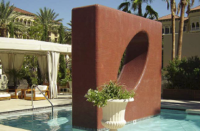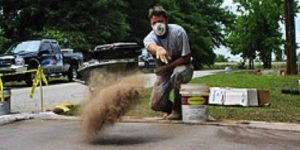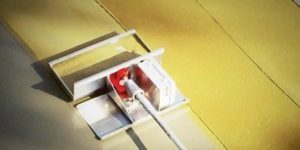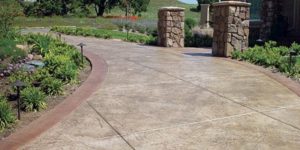 Floating dust-on color hardener into concrete is above and beyond floating an integrally colored slab, says Tom Ralston, president of Tom Ralston Concrete in Santa Cruz, Calif.
Floating dust-on color hardener into concrete is above and beyond floating an integrally colored slab, says Tom Ralston, president of Tom Ralston Concrete in Santa Cruz, Calif.
In this case, floating has to accomplish more than smoothing and flattening the surface, he says. It has to work the color hardener into the surface thoroughly so the moisture in the concrete can activate the hardener.
John Stefanowicz, owner of Applied Color Concrete in Wimberley, Texas, agrees. “The difference between working with color-hardened concrete and integrally colored concrete is substantial,” he says. “There’s more technique involved.”
There’s also more time involved — first, to broadcast the color hardener and, second, to float the hardener into the surface. “When you use the color hardener, you have to float a lot more to work the color in,” says Isaac Jonker, president of Nobel Concrete in Jenison, Mich. “You use a bull float or fresno, back and forth, until it goes into the concrete completely.”
Timing is important for successful application of color hardener. “If concrete has a lot of bleed water on it and you broadcast a heavy application of hardener to suck that moisture up, you can suffer some delamination or blotchiness of color,” cautions Bart Sacco, president of Concrete Texturing Tool & Supply in Throop, Penn. “Normally, the concrete gets struck off, bull-floated, and edged. If there’s any length of delay, where the concrete is skinning up, then you’d run your bull float over it again to knock that skinning off, and then apply the color hardener.”
The American Concrete Institute recommends a sequence specifically tailored for applying colored dry-shake hardeners and metallic dry-shake hardeners. The sequence is outlined in Section 8.6.2 of ACI Publication 302.1R?04, Guide for Concrete Floor and Slab Construction. “Color hardeners differ from hardeners that employ larger-sized hard aggregate and are used on industrial floors,” explains ACI senior managing director Ward Malisch. According to the document, “This difference … dictates that the material normally be embedded in the concrete later in the setting process than is common for uncolored mineral?aggregate dry?shake hardeners.”
“Some color hardeners are finer in consistency, some are grainier. Some work in real nice, and some don’t,” says Sacco. “After broadcasting 60 to 70 percent of the manufacturer’s recommended amount of color hardener in fine, even layers, watch the surface of the material. Give it somewhere around 60 to 90 seconds. It will go from being a dry powder to a moist powder. Then float it and work it into the surface of the concrete. As soon as you get that worked in, apply the remaining amount of material in the second application and float it in, with no delay between steps. That’s usually the part of the process that gets a little hairy — from the time the concrete’s on the ground till the hardener’s worked in.”
 “Sometimes, you have to add weight on the bull float to actually press this powder into the surface,” Stefanowicz says. “Most bull floats are either cupped to contain weight or there are pins you could put weights on. You want to have the weights strategically located, a third of the way in and a third of the way out.” He usually adds 6 pounds to 18 pounds, depending on how fast the concrete is setting. “The more wind and the more sun, the more weight,” he says. “Wind is the biggest foe on a project. As the wind blasts across the surface of the concrete, it’s literally pulling moisture out of the concrete. That’s when you put as much as 20 pounds on, and that’s really hard on the guys running the bull float.”
“Sometimes, you have to add weight on the bull float to actually press this powder into the surface,” Stefanowicz says. “Most bull floats are either cupped to contain weight or there are pins you could put weights on. You want to have the weights strategically located, a third of the way in and a third of the way out.” He usually adds 6 pounds to 18 pounds, depending on how fast the concrete is setting. “The more wind and the more sun, the more weight,” he says. “Wind is the biggest foe on a project. As the wind blasts across the surface of the concrete, it’s literally pulling moisture out of the concrete. That’s when you put as much as 20 pounds on, and that’s really hard on the guys running the bull float.”
“The type of float used for integral color typically depends on air entrainment and slump,” says Clark Branum, director of technical services for Brickform, which makes color hardener. “Air-entrained concrete should be floated with a magnesium bull float unless the slump exceeds 5 inches. Wood floats work best for hardener applications because they profile the surface, allowing the hardener to get better penetration. The wood float also aerates the surface, promoting bleed water and helping wet out the material. After the first coat of hardener is in place a magnesium float may be used.”
However, advice about what type of float works best varies among experienced installers. “It’s going to be a choice of personal preference. Some guys use wooden floats, some use magnesium floats, and some use resin floats.” Sacco says. “Also, different men in different parts of the country use different tools, depending on the different mix designs.” He explains that he uses a magnesium float because the Pennsylvania climate requires “a very strong mix of concrete and a decent amount of air entrainment, which makes the concrete very gummy.”
Mike Riggs, president of Progressive Concrete Works Inc. in Phoenix, reports using magnesium floats, even though he believes wood floats are a little more effective at working the hardener into the surface. “A wood float will have a tendency to leave the concrete surface more open, so it will dry a little bit quicker,” he explains. In triple-digit heat, that can be a problem.
 Stefanowicz also uses magnesium bull floats in Texas. “The concrete doesn’t stick to it as much, and it tends to open up the concrete as it’s running across, allowing moisture to come up,” he says. “Then at the very end, you can use a steel bull float, or fresno, for fine-tuning.”
Stefanowicz also uses magnesium bull floats in Texas. “The concrete doesn’t stick to it as much, and it tends to open up the concrete as it’s running across, allowing moisture to come up,” he says. “Then at the very end, you can use a steel bull float, or fresno, for fine-tuning.”
Hand floats can be used to create decorative effects. Sacco says that after the hardener has been worked into the surface, a hand float can be used to create border patterns such as half-moons, figure eights, or swirls.
In addition to performance qualities such as resistance to abrasion and moisture, color hardeners offer unique decorative possibilities. “One of the major advantages of dry-shake color hardener, over an integral color, is you’re going to have a broader pallet of colors to work from,” Riggs says. “You can get a more intense dark color. And you can get almost a white color that you can’t achieve with an integral color concrete unless you use a white portland cement.” The way the color hardener is worked into the surface can enhance its decorative effect. “Depending on what kind of effect you want to create, you’re going to apply the color hardener either lighter or heavier,” he says. “Then you can use the float to make those areas bleed out a little bit more, so they kind of fade out.”
Often, color hardener is used sparingly, as an accent, rather than completely covering the surface. “You can achieve much more mottling with dust-on colors, especially if you use more than one color,” says Ralston. “You can actually produce an oil-painting effect in which the concrete then becomes a concrete canvas.”
















